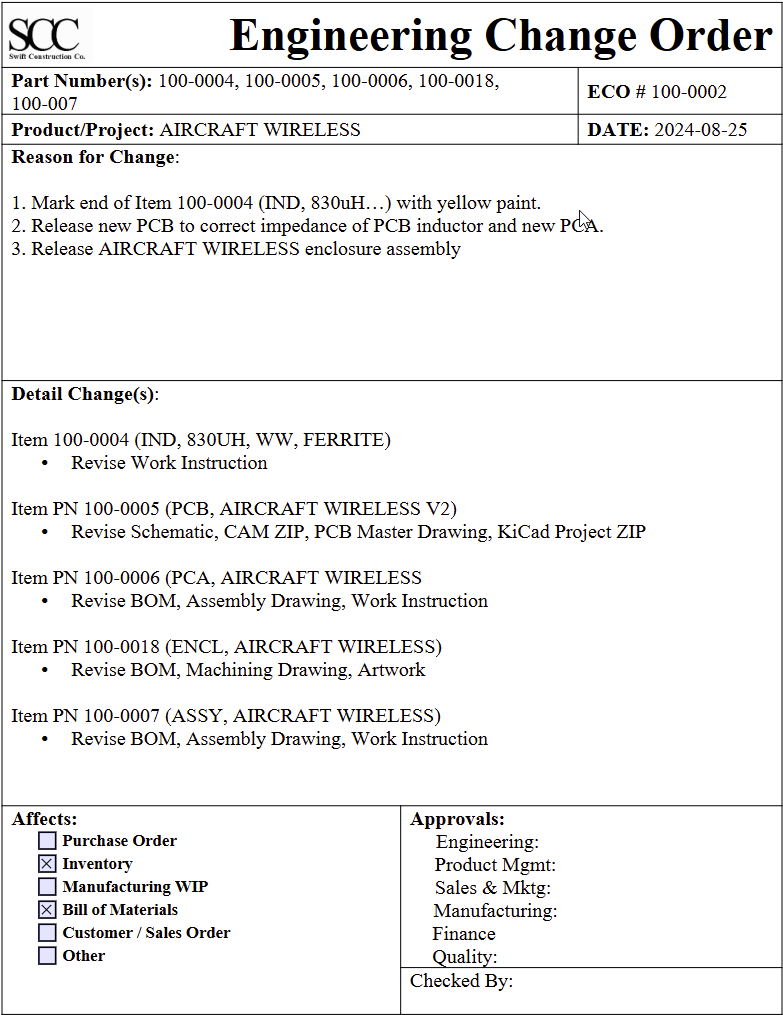Goals
- Learn terminology and theory related to items and change management.
Items
In webERP and many other ERP systems, an Item is a fundamental concept that represents any tangible product, intangible service, or component that a business buys, sells, manufactures, stores, or uses in its operations.
An item is essentially a master record that holds all the relevant information about a specific product or service within the company’s ecosystem. Think of an item as the “DNA” of every single good or service your company deals with. This detailed record is often housed in what’s called the “Item Master” and serves as a single source of truth for various departments across the organization.
Items that are manufactured are made up of other items. A Bill of Materials (BOM) lists the child items (and quantities) that make up the parent item. A manufacturing process converts child items into parent items, and input and output terminology may be used. An item with a BOM might also be called a manufactured item or an assembly.
Here’s a breakdown of the key characteristics and information stored for an item in webERP and what makes it so crucial.
Identification
- Item Number/Code/SKU (Stock Keeping Unit): A unique identifier for the item.
- Name/Description: A clear and concise name and detailed description of the item.
- Barcodes/Part Numbers: For tracking and identification, especially for physical goods.
Physical Attributes (for tangible items)
- Dimensions (Length, Width, Height): Important for storage and shipping.
- Weight: For shipping costs and logistics.
- Unit of Measure (UOM): How the item is bought, sold, or stocked (e.g., each, box, meter, kilogram).
- Packaging Details: Information about how the item is packaged.
Inventory & Stocking
- Current Stock Levels: Real-time quantity on hand.
- Minimum/Maximum Stock Levels: Thresholds for reordering and preventing stockouts/overstocking.
- Reorder Point/Quantity: When and how much to reorder.
- Warehouse Location(s): Where the item is stored.
- Lot/Batch Numbers: For traceability, especially for perishable or regulated goods.
- Serial Numbers: For unique identification of high-value items.
- Expiration Dates: For perishable goods.
Procurement & Sourcing
- Supplier Information: Preferred vendors, contact details.
- Purchase Costs: The cost to acquire the item.
- Lead Times: Time required from ordering to receiving the item.
- Minimum Order Quantities (MOQ): Smallest quantity that can be ordered from a supplier.
Sales & Pricing
- Sales Price: The price at which the item is sold to customers.
- Discount Structures: Applicable discounts.
- Customer-specific Pricing: Special pricing for certain customers.
- Tax Information: Applicable taxes.
Manufacturing & Production (for manufactured items)
- Bill of Materials (BOM): A complete list of raw materials, components, and sub-assemblies required to manufacture the item.
- Routing/Production Steps: The sequence of operations needed to produce the item.
- Manufacturing Lead Time: Time required to produce the item.
- Work-in-Progress (WIP) Tracking: Status of items in the production process.
Financial & Accounting
- Cost of Goods Sold (COGS): The direct costs attributable to the production of the goods sold by a company.
- Inventory Valuation Method: (e.g., FIFO, LIFO, Weighted Average).
- General Ledger Accounts: Linkages to accounting categories.
Categorization & Classification
- Product Category/Type: For organizing and reporting.
- Item Class: Defines a set of common attributes for a group of items.
Lifecycle Information
- Status: (e.g., Active, Obsolete, Discontinued).
- Revision History: Changes made to the item’s specifications over time.
An “Item” is the cornerstone of an ERP and enables:
- Centralized Data – a single, consistent source of information for all departments, eliminating data silos and discrepancies.
- Inventory Management – accurately track stock levels, automate reordering and optimize inventory holding costs.
- Procurement – streamline purchasing by providing supplier details, costs, and lead times, facilitating efficient order placement.
- Sales and Order Fulfillment – ensure accurate pricing, availability checks, and efficient order processing and shipping.
- Manufacturing – provide data for production planning, scheduling and cost calculation through BOMs and routing.
- Financial Management – accurate cost accounting, inventory valuation, and financial reporting.
- Reporting and Analytics – granular data for in-depth analysis of sales trends, inventory performance, supplier performance, and profitability.
- Automation – automation processes, such as automatic reordering or invoice generation, rely on accurate item master data.
- Traceability – serialize and lot-track items with detailed tracking of each item’s journey through the supply chain.
An “item” is not just a description of a product but a comprehensive data package that drives and integrates virtually every operational and financial process within an ERP system and an organization.
Change Management Process
A change management process is the process by which items and BOMs are first created and managed over time as needs change.
Convention prohibits the essence of an item (its fit, form and function) to be changed once created. Because an item is not allowed to change, it by definition cannot be revised and hence an item does not have a revision level.
However, documentation related to an item is allowed to change. This happens when documents are corrected or improvements or changes are made (but without affecting the item’s fit, form or function). To identify changes to a document, a two-level revision code is often used, with a change in major code indicating a change affecting the item and a change in minor code indicating only the documentation changed (e.g. a correction or clarification).
A milestone in the lifecycle of a product is called a Release , which is a snapshot of all the items and associated documents at a particular point in time or gate between one phase of the product or item lifecycle and the next (such as from design to manufacturing).
An organization often defines a change management process, which generally uses a form listing the affected Items and documentation, the reason for the change, and record of approval by all affected parties.

Product Lifecycle Management
Product lifecycle management (PLM) is the general process of managing a product and all it’s sub-assemblies from creation to termination (aka cradle to grave). PLM integrates people, data, processes and business systems, and provides a trustable and transparent product information backbone for operations.
